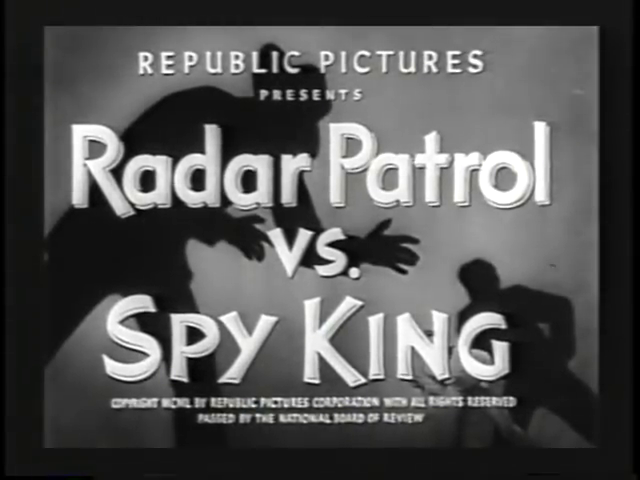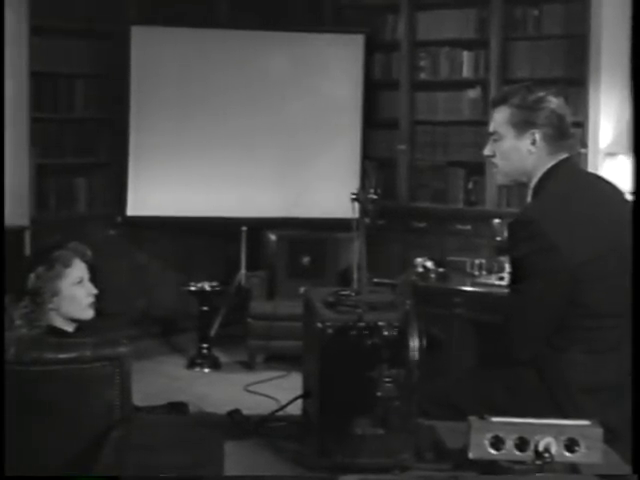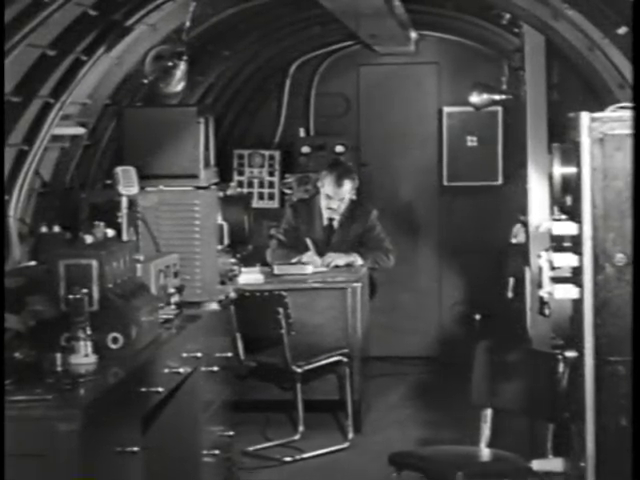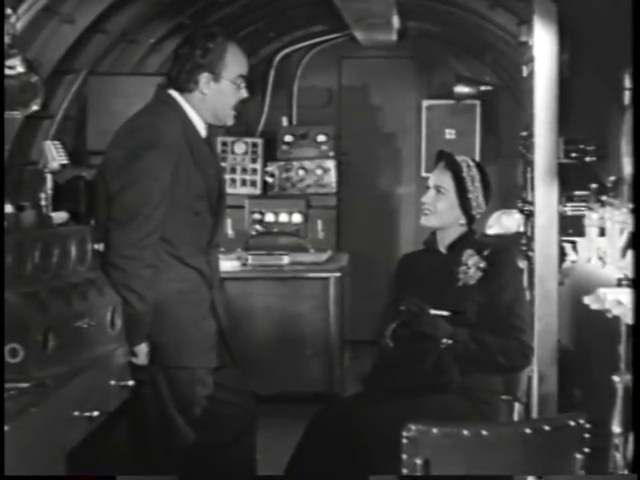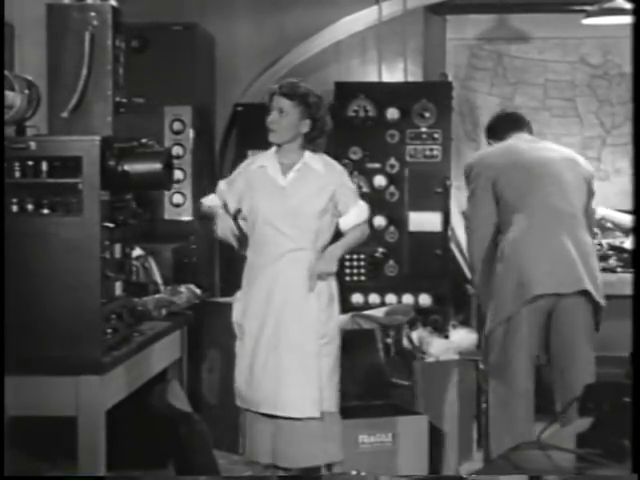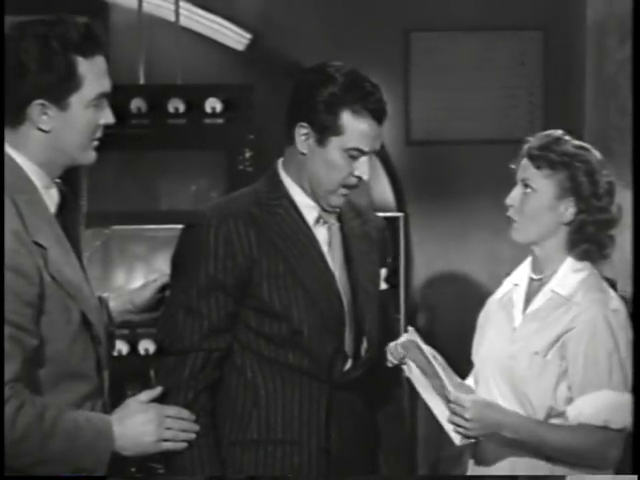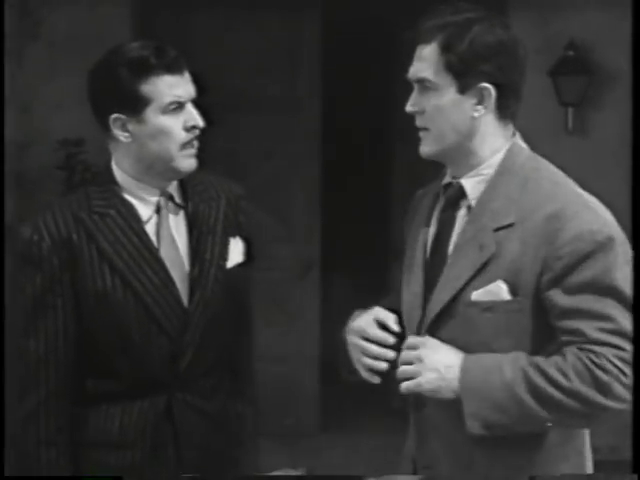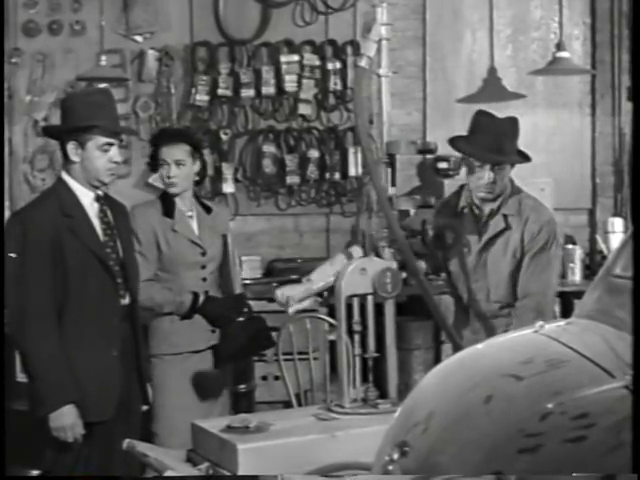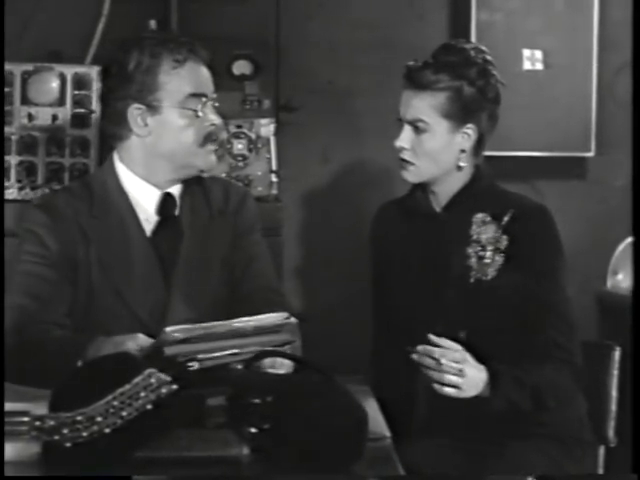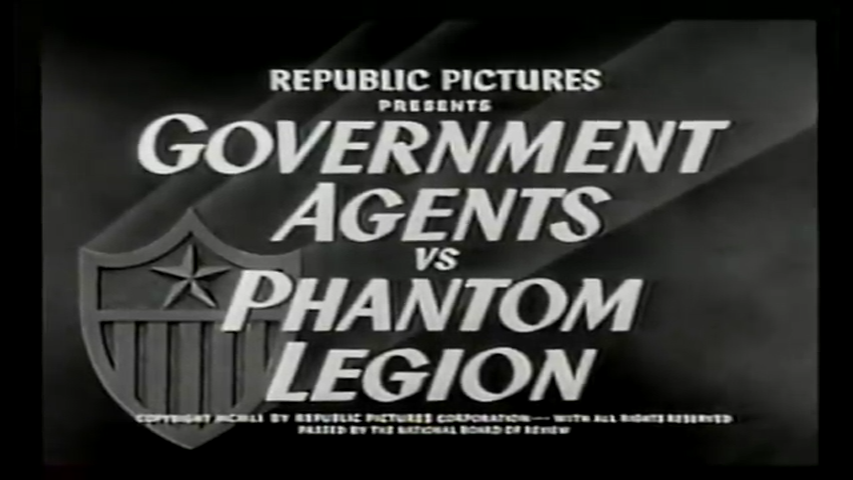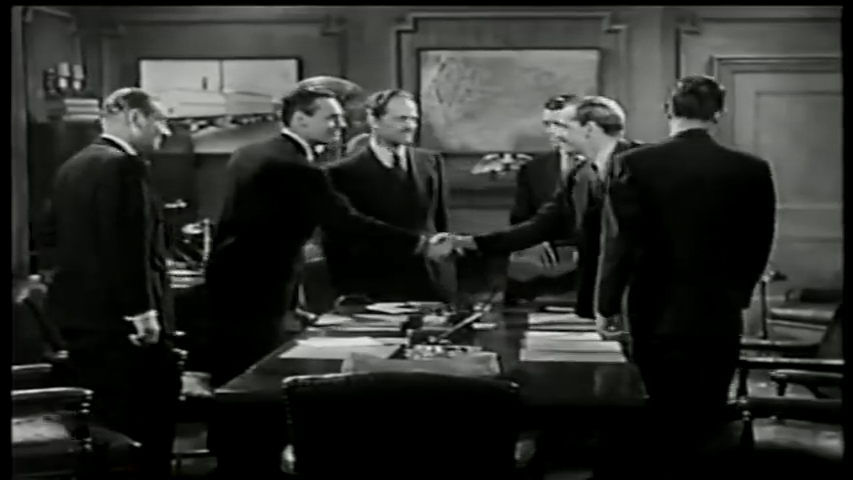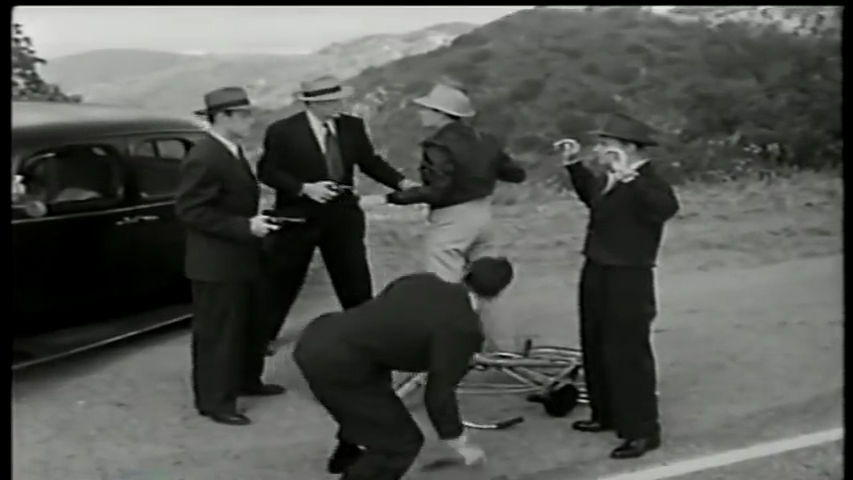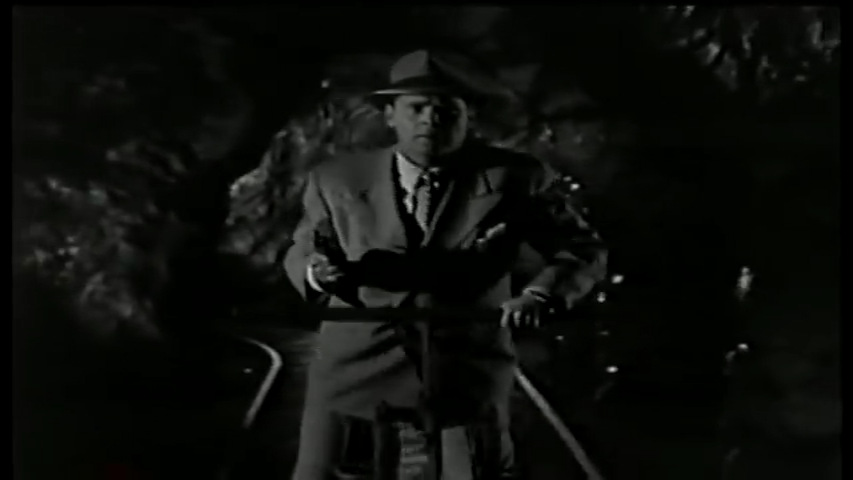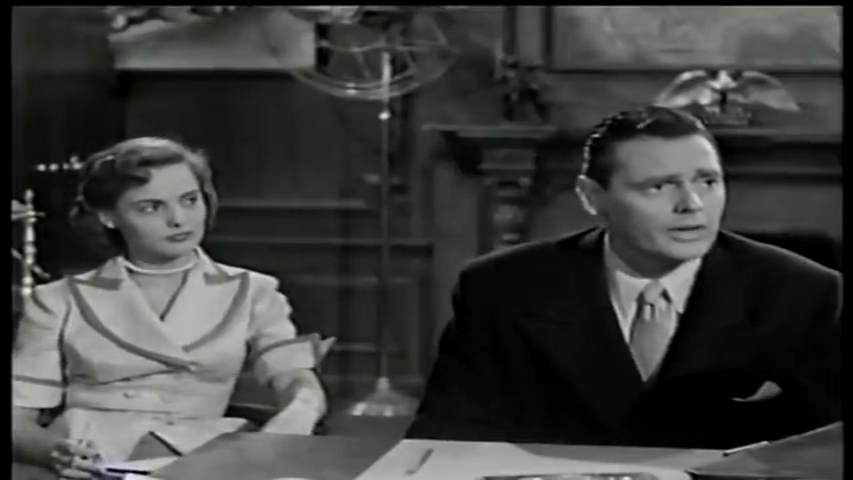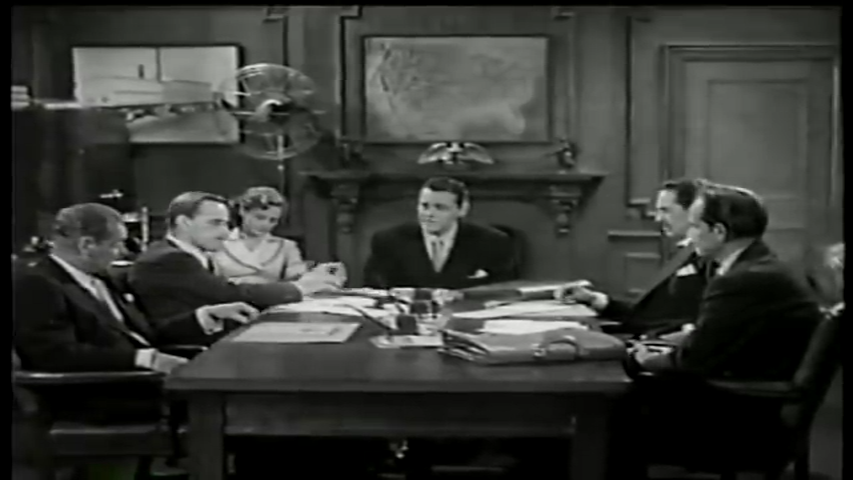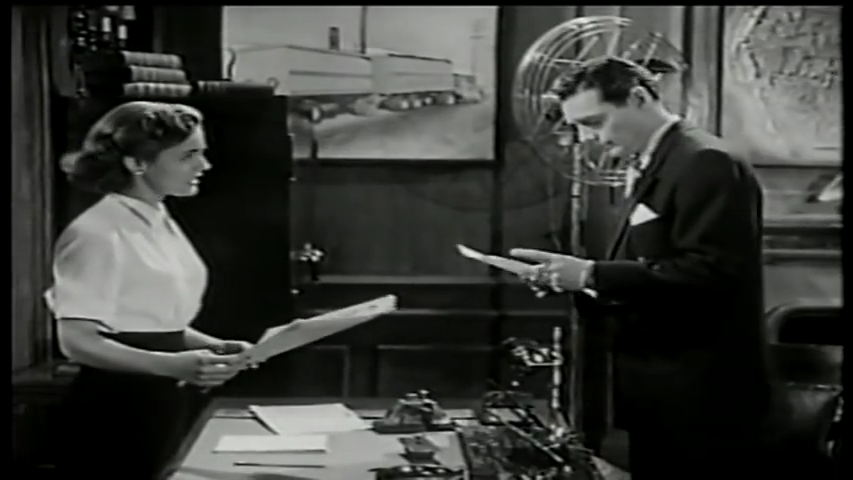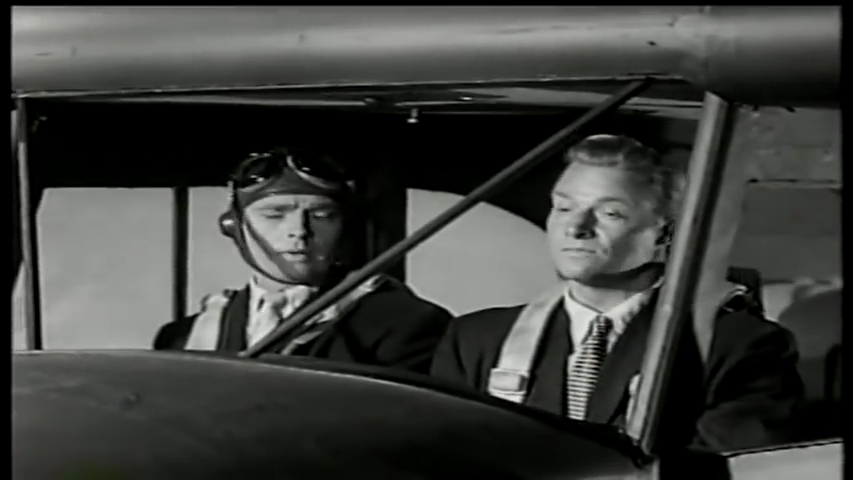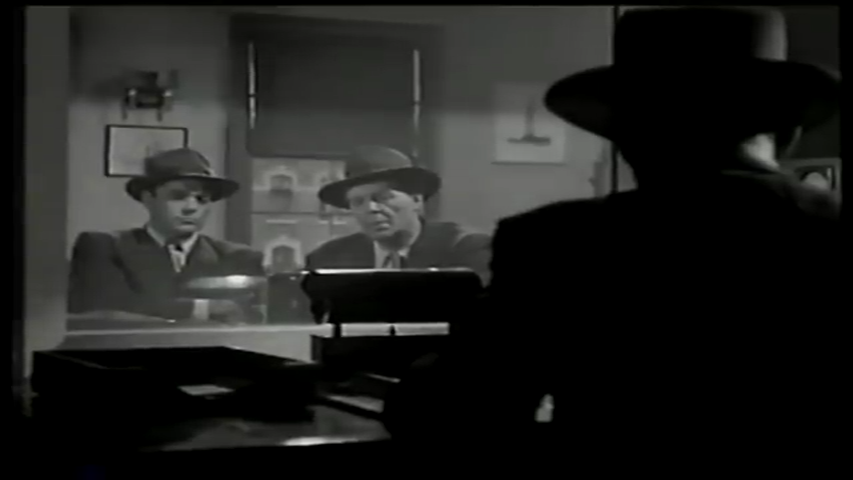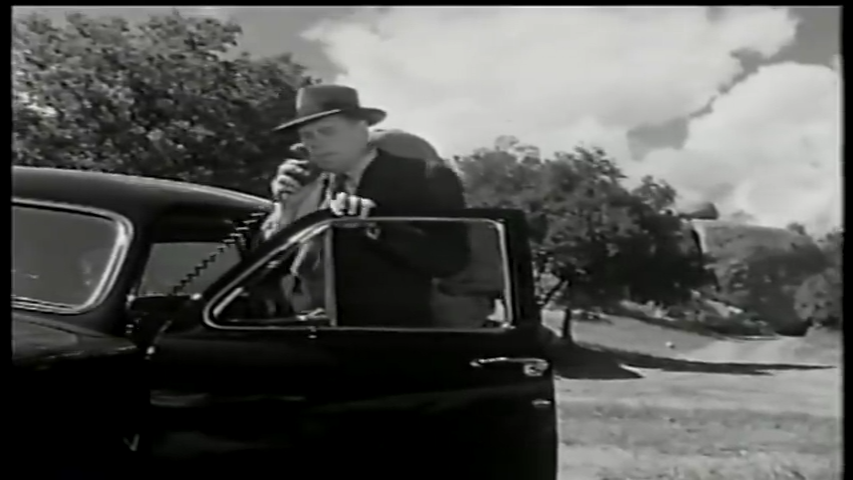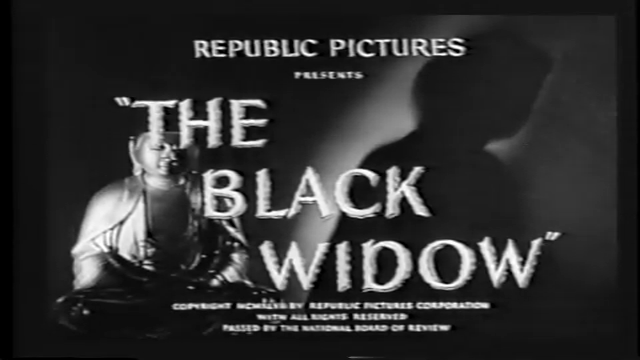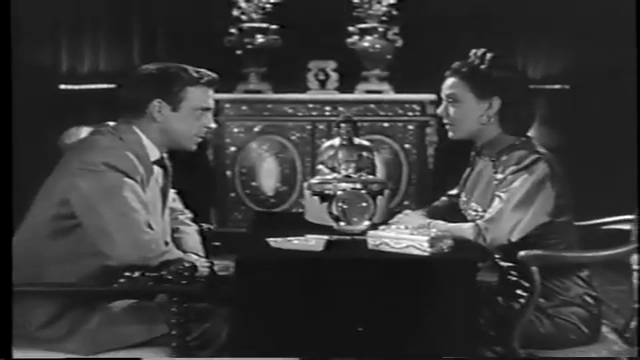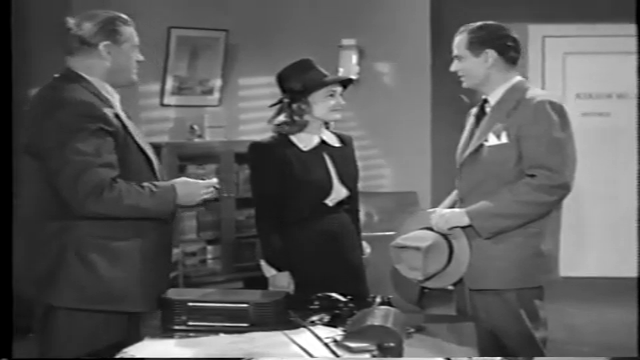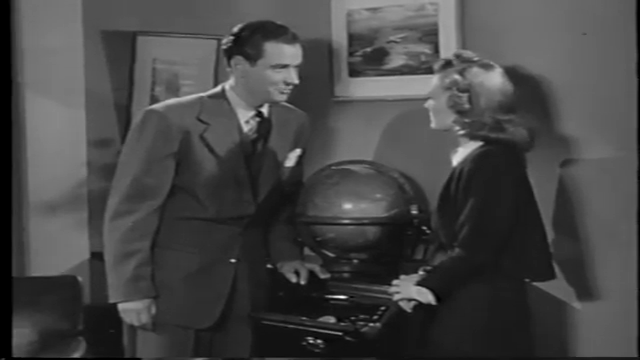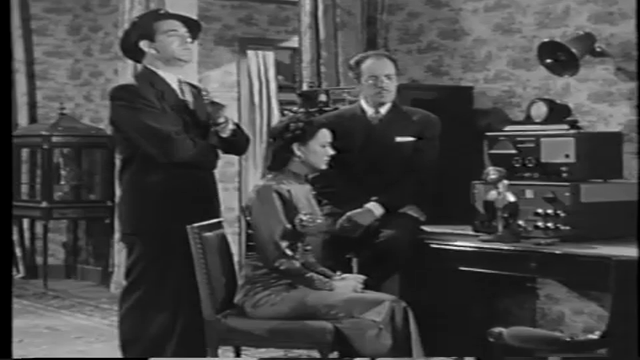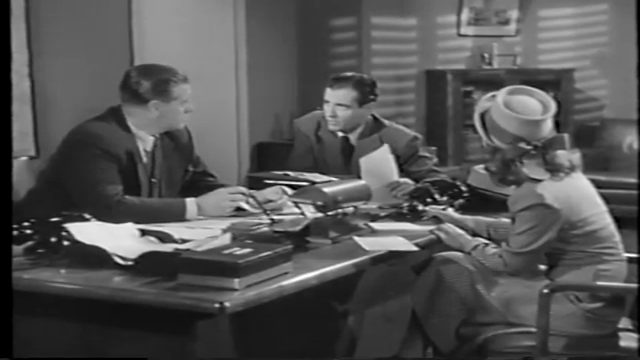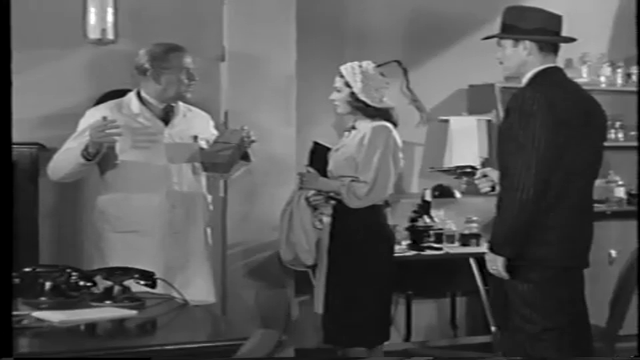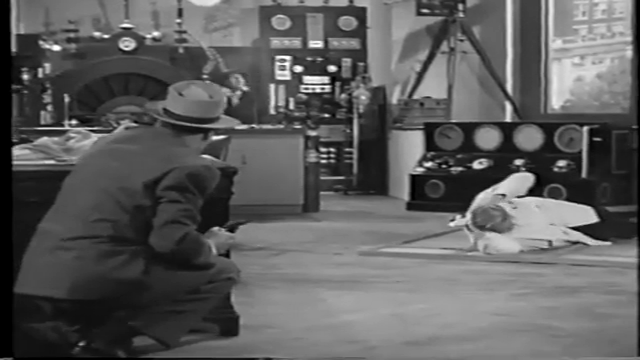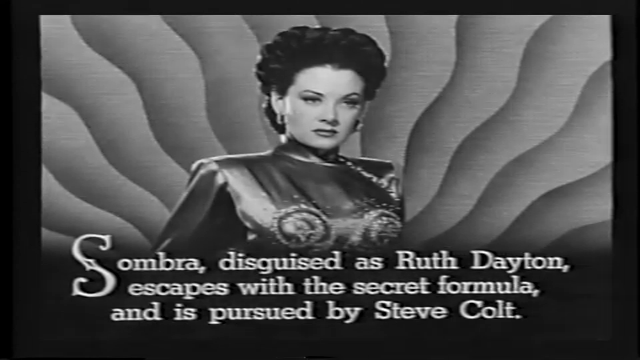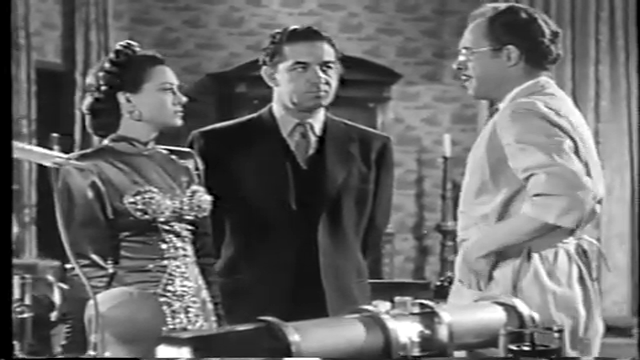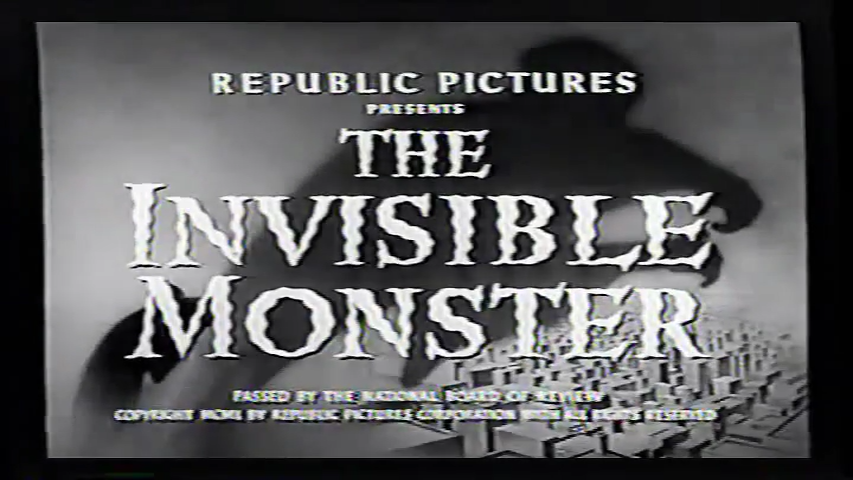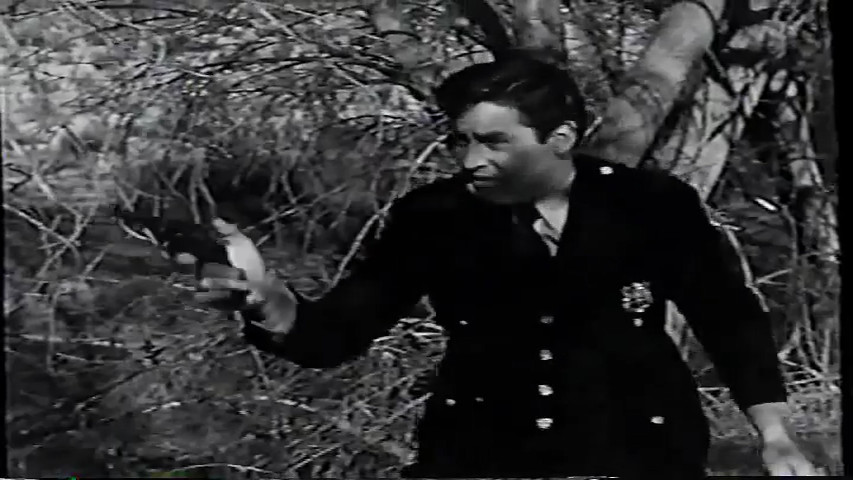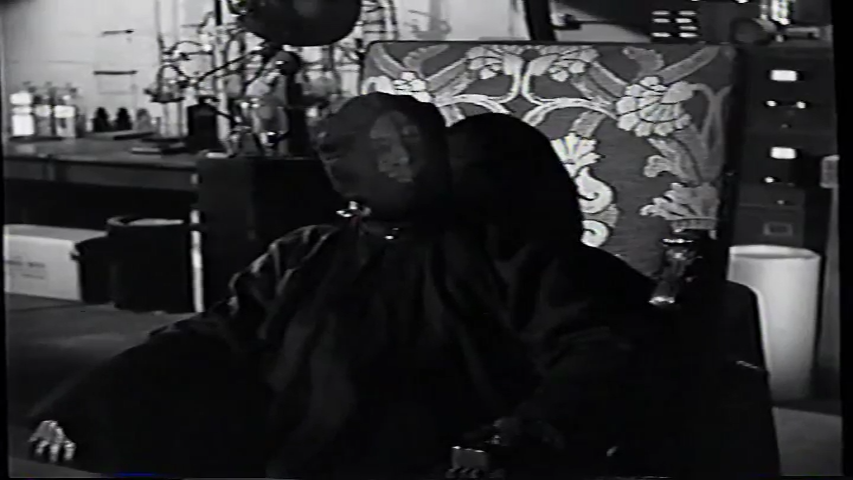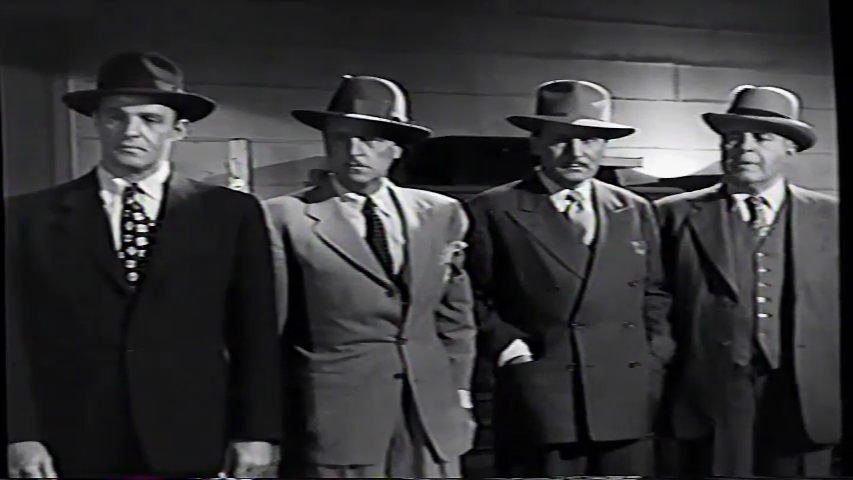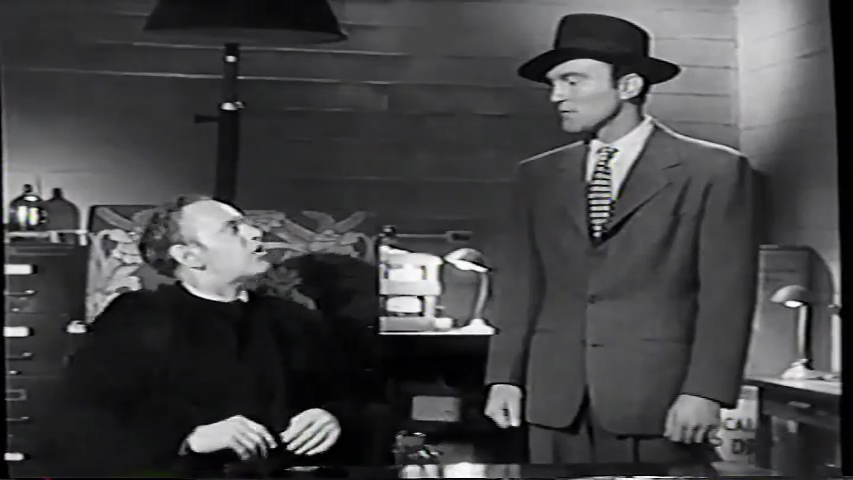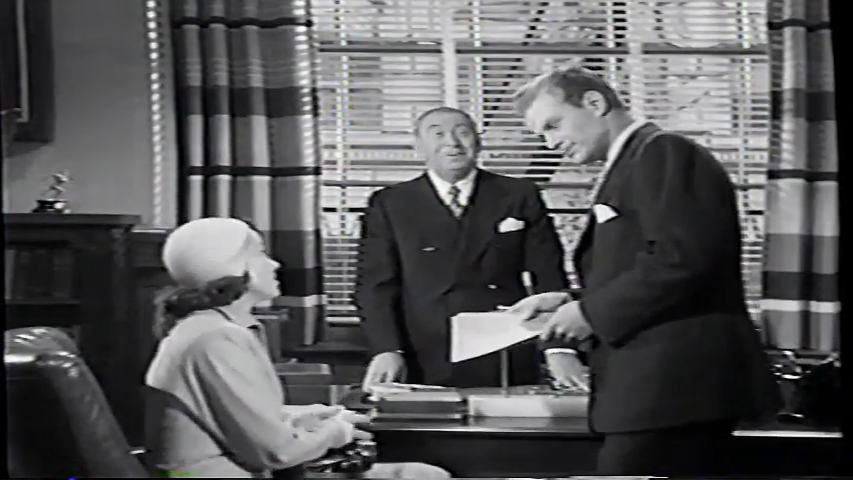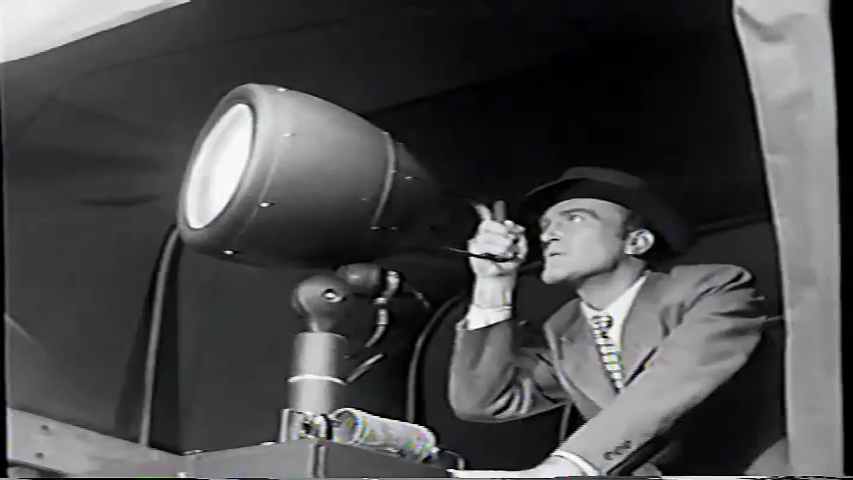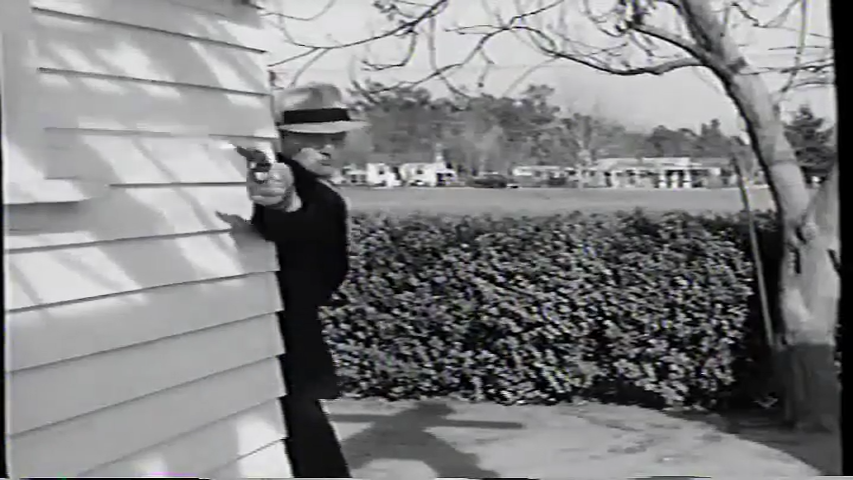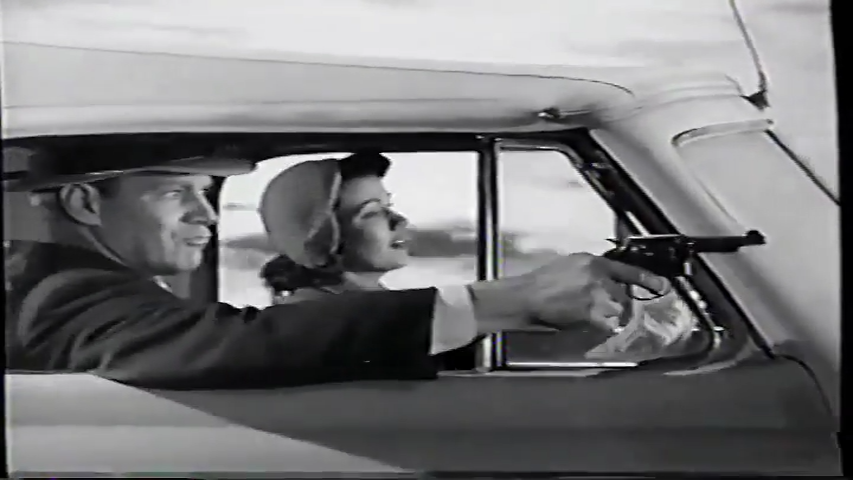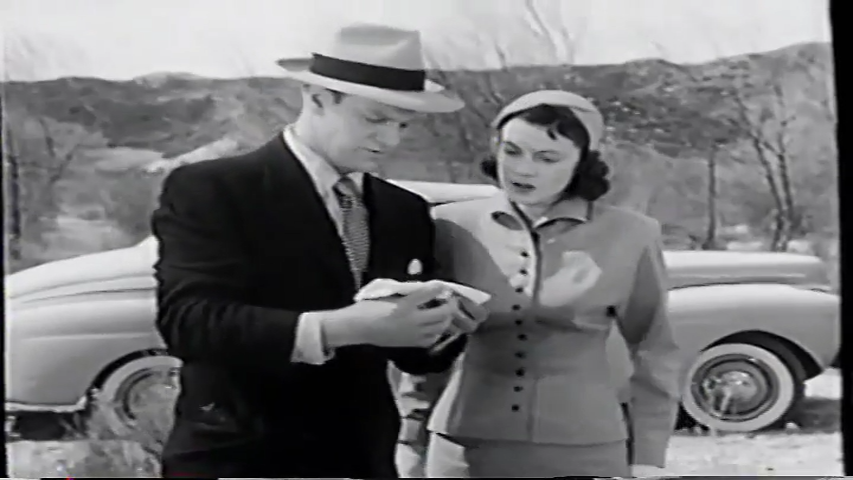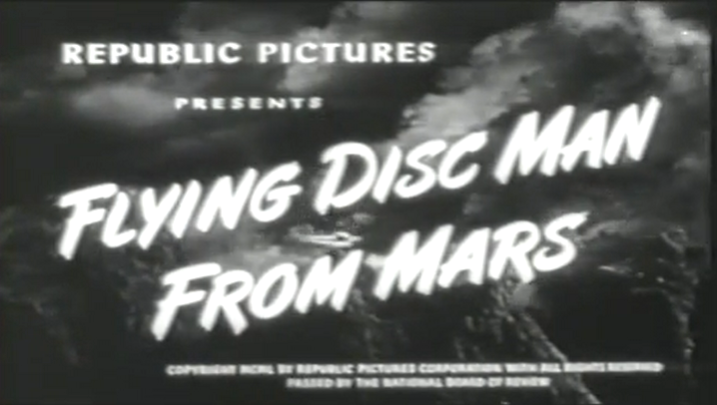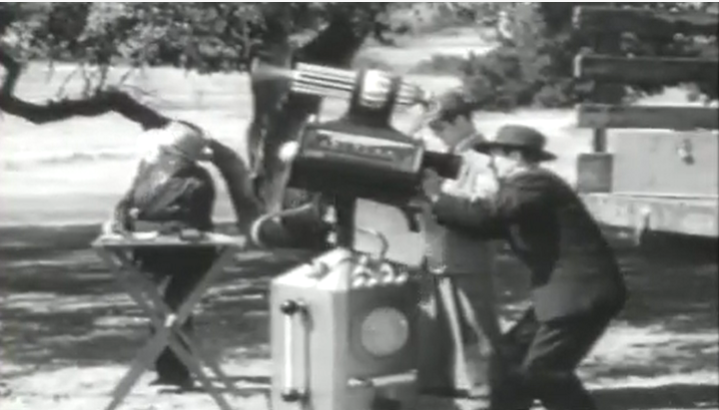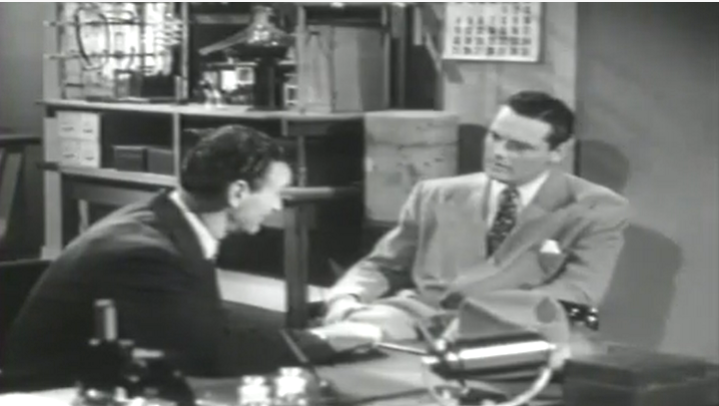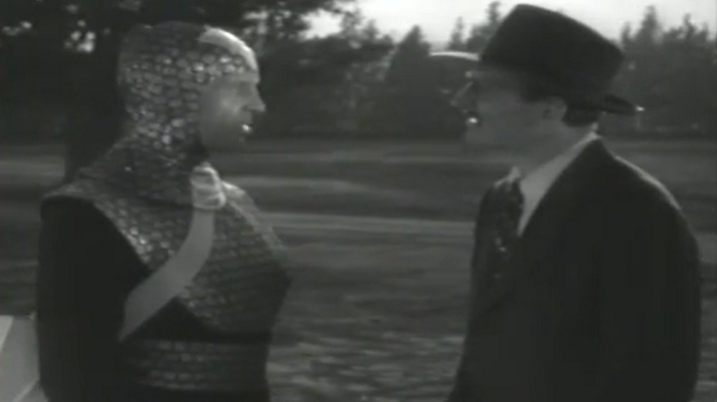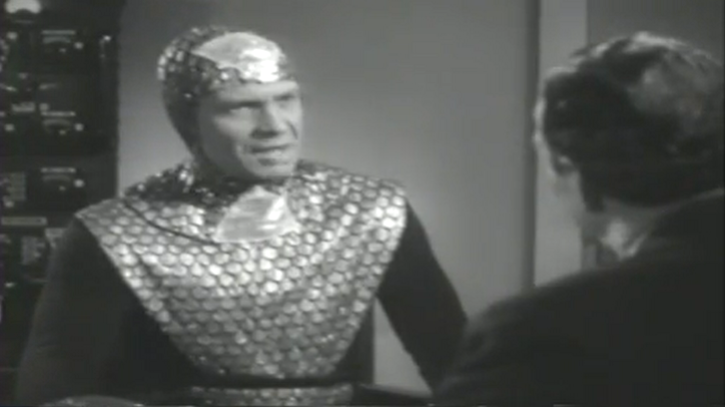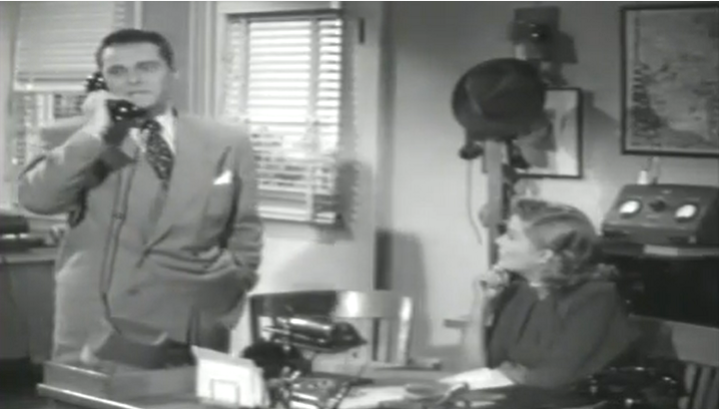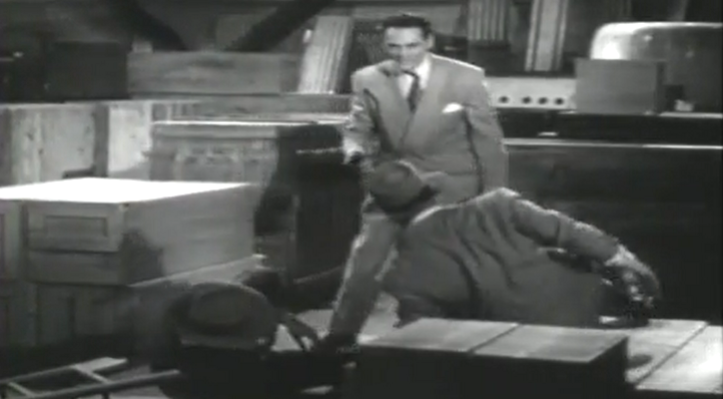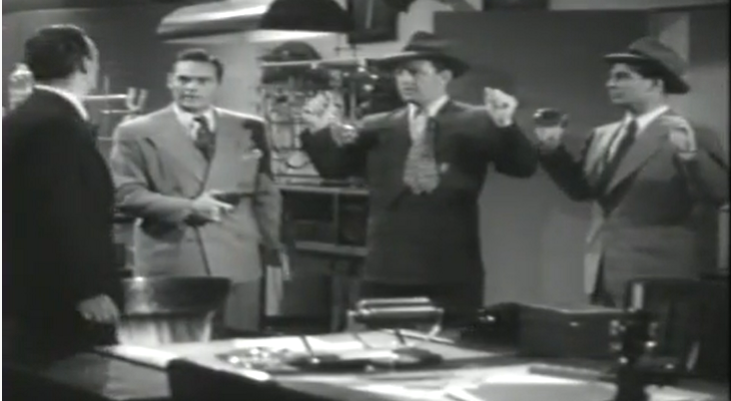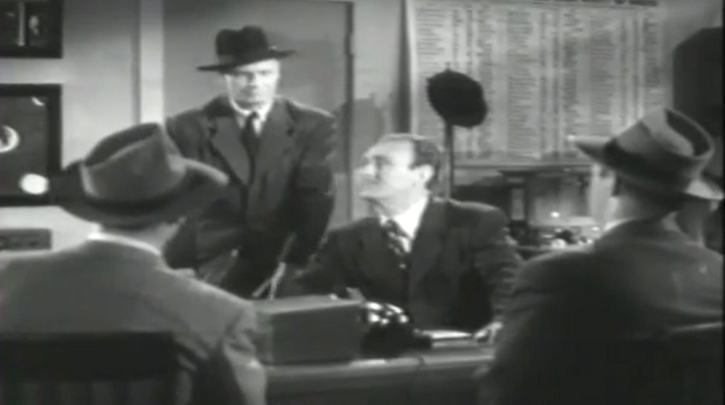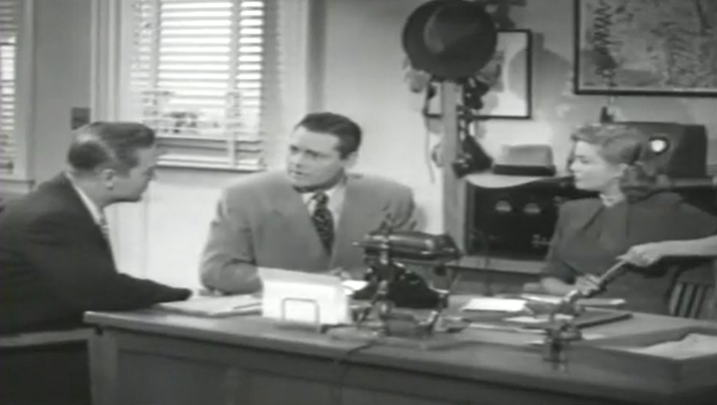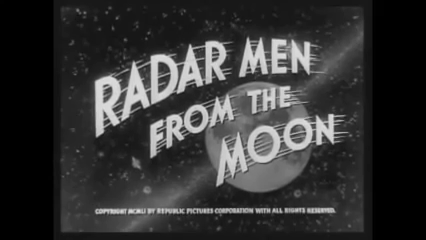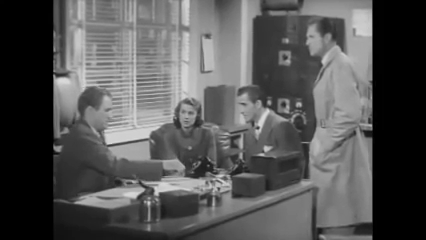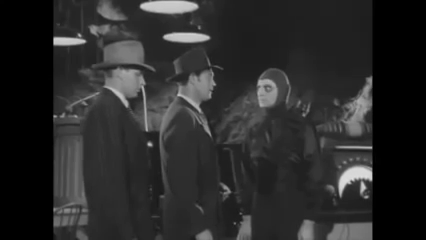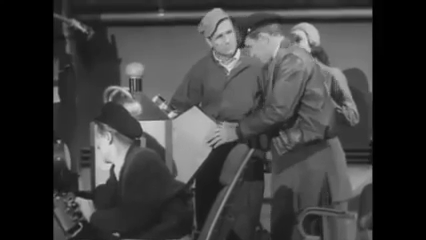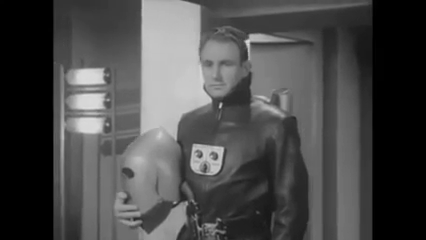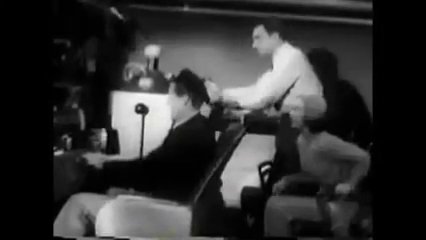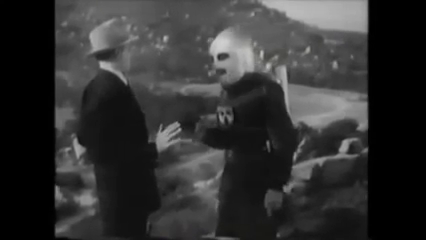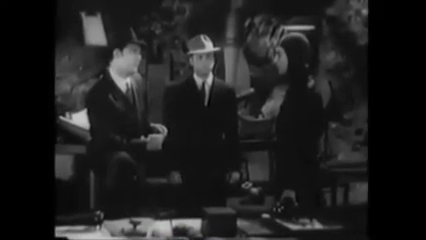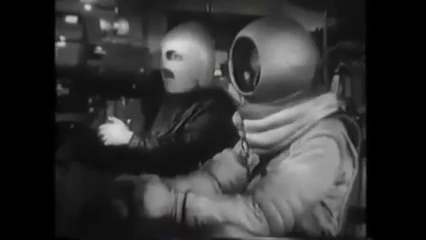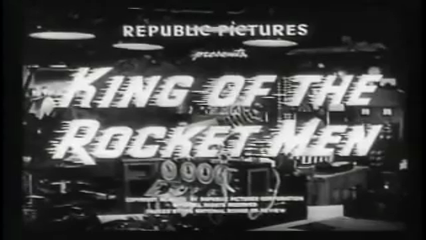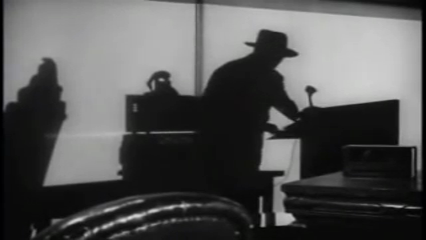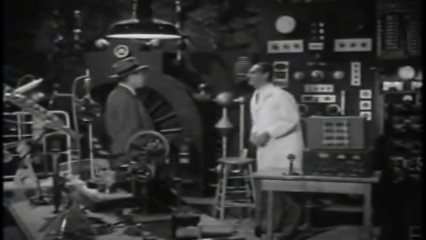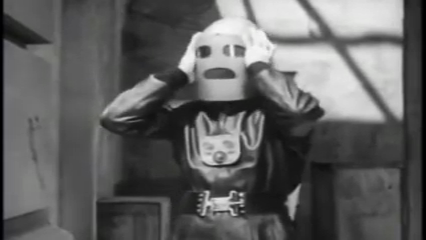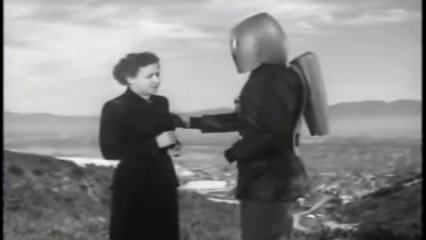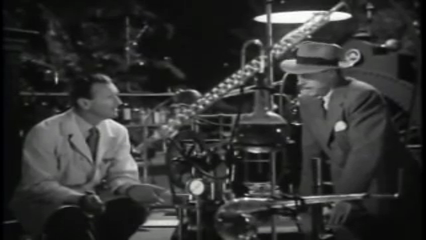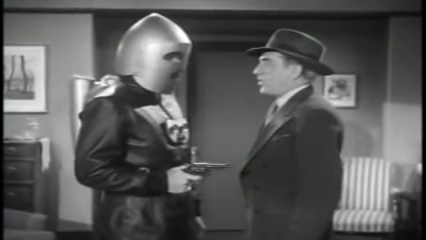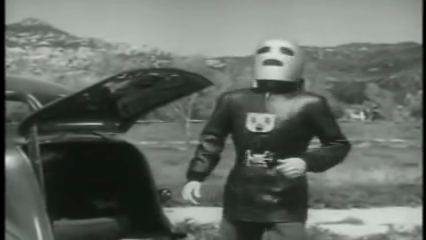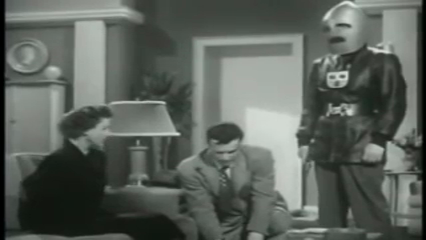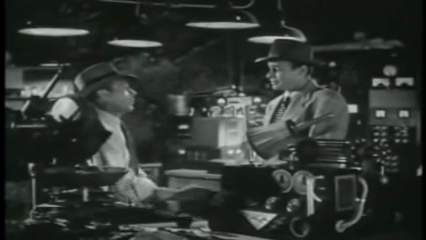-
#454 – Radar Patrol vs Spy King (1949)
Radar Patrol vs Spy King (1949)
Film review #454
Director: Fred C. Brannon
SYNOPSIS: A new radar defense system is being constructed that will cover the entire United States, but it’s completion is being interrupted by a series of attacks led by neo-nazi spy John Baroda and his henchman. Chris Calvert, agent for the Radar Defense Bureau, is assigned to supervise the completion of the radar with the help of Joan Hughes, who is in charge of the project. Together with Mexican agent Lt Manuel Agura, they work to complete the radar station while stopping The Spy King Baroda and his henchman from preparing a foreign invasion…
THOUGHTS/ANALYSIS: Radar Patrol vs Spy King is a 1949 serial comprised of twelve chapters. The serial opens up with the usual display of explosions signifying attacks that are disrupting the completion of a new radar system across the United States. The attacks are being led by “The Spy King” John Baroda, alongside his assistant Nitra and their henchman, who intends to disrupt the radar system in aid of a foreign power. Radar defense bureau operative Chris Calvert is assigned to the project, being developed by Joan Hughes, and they work together with Mexican agent Lt Manuel Agura to bring down the Spy King. The plot follows a very typical serial format, with each chapter usually beginning with the heroes or villains explaining what is going to happen in the current chapter, and then…you watch it happen. There’s never any real surprises, and the set-ups and chase scenes have all been done before. There’s a fair amount of explosions and action that form the basis of the cliff-hangers, but they are resolved in a nonchalant way as usual.
Heading up the heroes is Chris Calvert, the typical male lead with no distinguishing features whatsoever. Joan Hughes as the typical sole female character, although she does have a job other than secretary or reporter, and she only gets kidnapped once, both of which are rare for women in these serials. The villain is rather uninteresting, and the character of a Neo-Nazi spy is a trope that was used during the war and a while after for villains, as the fear of “the enemy within” and saboteurs that live among us was a theme that was quite powerful, and continued for many years after. I recognise some of the actors as being in other serials, which is a sign that I have watched way too many of these, and also that a lot of them are completely interchangeable in different serials; the actors that play the henchman always play them, and a lot of the female characters are played by the few female actors of the time.
As mentioned, the action scenes and explosions are decently done, and give the serial a bit of excitement, but there’s very little in terms of the plot or characters which sets itself apart from any other serial. The cliffhangers are sometimes a bit more inventive, but that’s all that stands out. Given that this serial came out past the peak of the format’s popularity, there is not much original that could have been done. The acting shows it’s weakness in the dialogue that awkwardly explains the plot rather than showing it, but for the rest of the time it’s passable. Overall, Radar Patrol vs Spy King is nothing special, and falls into the large pile of forgettable serials. It doesn’t have any huge problems, but avoids anything too disastrous in its production to make it any less than average.
-
#450 – Government Agents vs. Phantom Legion (1951)
Government Agents vs. Phantom Legion (1951)
Film review #450
Director: Fred C. Brannon
SYNOPSIS: A company carrying materials by truck to be used for military defense are being hijacked in transit by foreign agents. The company is assigned government agents Hal Duncan and Sam Bradley to put a stop to the criminals. Suspecting that one of the managers of the company is actually the ringleader of these hijackings, the agents must work to dismantle the crime ring and unmask the person responsible…
THOUGHTS/ANALYSIS: Government Agents vs. Phantom Legion is a 1951 serial comprised of twelve chapters. The plot is simple enough: a company which transports materials in trucks is being subjected to a number of hijackings. To resolve the situation, government agents Hal Duncan and Sam Bradley are brought in to bring the perpetrators to justice, as their investigation leads them to suspect that one of the four managers themselves is the ringleader of the gang of criminals. If that plot summary doesn’t sound very interesting, that’s because it’s not. There aren’t any real novel, unique or interesting elements to the story that give it anything to stand out. A plot centering on hijacking trucks just doesn’t compare to the fantastic adventures of Flash Gordon, and the characters of Hal Duncan aren’t particularly memorable or recognisable like Dick Tracy. The serial itself unfolds in typical serial format, with the heroes trying to thwart the villain’s various schemes while getting into brawls and gunfights. There really isn’t anything else to say on the story, because it is so devoid of life or interest that it’s difficult to pay attention while watching.
As mentioned, the lead characters are pretty unremarkable: the serial is not based on an existing comic, book or other media, and so there’s no prior name recognition to get people into the theatre, which is going to hinder this serial further when it already has nothing going for it. The lead characters are bland and uninteresting, and don’t have any notable features. They are aided by the company’s secretary, who of course serves as the only female in the cast doing one of only three jobs that women do in these serials (secretary, journalist, or daughter/niece of another character…which isn’t really a job). The four managers of the company, of which one of them is the criminal ringleader, are equally uninteresting, and given that they are all middle-aged white men with the same moustache, there’s really nothing to tel them apart, and it doesn’t really matter which one of them it is. The mysterious villain isn’t even given a name or identity, and is only seen as silhouette from behind. There’s no real attempt to create a compelling villain, and the mystery of the villain is something that has been done by far too many serials to mention.
The serial is packed with the usual cliffhangers, typically resolved by Hal escaping danger by jumping out of the way at the last second before a car goes over the cliff, a building explodes etc. Nothing special to write about there. The serial was released in 1951, way past the peak of the popularity of the serial format, and all of it’s tropes had been done to death. There’s some decent shots, and the action sequences are choreographed fairly well. Fred C. Brannon, the director, directed many serials before this, so he obviously knows what he is doing, but the story and characters are so lifeless, and the stakes centred about a trucking company leads to there being little to invest in. Overall, Government Agents vs. Phantom Legion is not the best example of the serial format, and well past the peak of the format.
-
#449 – The Black Widow (1947)
The Black Widow (1947)
Film review #449
Directors: Spencer Gordon Bennet, Fred C. Brannon
SYNOPSIS: A series of murders involving poison from a venomous spider leads the editor of the Daily Clarion newspaper to hire amateur criminologist Steve Colt to investigate. He is joined by Joyce Winters to investigate the work of the criminal known only as the “black widow,” who is attempting to steal a prototype rocket project for undoubtedly evil ends…
THOUGHTS/ANALYSIS: The Black Widow is a 1947 serial comprised of thirteen chapters. In the opening, we see a man fall victim to a venomous spider bite, orchestrated by Sombra, a foreign agent disguised as a fortune teller. Adding this man to her killing spree, the Daily Clarion newspaper aims to uncover the secrets of this killing spree by hiring amateur criminologist Steve Colt to unravel the mystery. The story is a very familiar setup, with the basic premise being the protagonist’s having to foil the antagonist’s schemes through car chases, fistfights and the like. It all feels very familiar, and the plot never really progresses beyond this back and forth. A major part of the plot revolves around Sombra trying to get a hold of a prototype rocket project, but it doesn’t really go anywhere or add anything to the story. While almost all of the serials follow the same format and low budget production, the best ones are able to provide something that is reasonably unique to help drive the story and set itself apart from other serials, but The Black Widow doesn’t really have anything; no, an unconvincing plastic spider coming out of a chair to poison it’s victims once or twice doesn’t count.
The characters don’t really help give the serial an original edge. Steve Colt as an “amateur criminologist” is a role that a lot of the serial leads have. It’s a wonder how so many “amateur” criminologists are able to bring down crime bosses with little to no help from the police. Joyce Winters provides the “lead” female role, which is to say she has a small part to play in the serial other than being kidnapped (although she does that too), and it’s good to see more than one female character playing a role in the serial. Sombra as the villain is cold and ruthless, but spends a lot of time just giving orders. Her ability to put on masks and disguise herself as other people seems to be otherworldly, but lacks explanation and justification. Carol Forman, the actress who played Sombra, often played the role of female serial villain, and played a similar character in the 1948 Superman serial, where she played the criminal mastermind the “Spider Lady.” The rest of the character don’t make much of an impact on viewers, and are quickly forgettable. Sombra’s Father, King Hitomu, appears through the use of a device that apparently transports him across the world from presumably east Asia somewhere (although the characters are white they are obviously made up to “look” Japanese, as a lot of serial villains were in response to their role against the U.S. in WWII). Having a transportation device that can take you across half the world instantaneously should probably be more of a deal than the serial makes it out, using it so Hitomu can appear, give his orders, and then disappear again. The plot of the experimental rocket weapon just seems to pale in comparison to such a device. His motivation also just seems to be limited to “conquering the world,” which doesn’t really say anything about his character.
Released in 1947, the serial was released after the peak of the format’s popularity, and the continually recycled tropes had mostly run their course as Hollywood was turning away from low budget serials to feature films that could be more experimental and bold in the post-war boom. That said, with directors Spencer Gordon Bennet and Fred C. Brannon attached; two of the veteran serial directors, the action scenes and camerawork are decently co-ordinated. The acting is often pretty rough, and the dialogue unnatural, as these serial s often try and recap past events through dialogue for people that have missed chapters. There’s some inventive setups and scenery, with hidden switches, and imaginative devices that the villains use to implement their schemes. Overall, The Black Widow benefits from the experience of it’s production staff, but fails to come up with an original story or interesting characters to justify going through all thirteen chapters.
-
#437 – The Invisible Monster (1950)
The Invisible Monster (1950)
Film review #437
Director: Fred C. Brannon
SYNOPSIS: A criminal known only as the “phantom Ruler” has devised a way to turn invisible by covering his clothing in a special chemical and remaining under a specific light source. He coaxes some men who have illegally entered the country to be his underlings, setting them up in various jobs to sabotage security and such in order to commit crimes. Insurance agent Lane Carson is tasked with investigating the incidents, alongside his new assistant Carol Richards, and stopping the Phantom Ruler from getting the necessary materials for creating an invisible army…
THOUGHTS/ANALYSIS: The Invisible Monster is a 1950 serial by Republic Pictures comprised of twelve chapters. The story is a familiar one to serial-watchers, as insurance investigator Chase Lane is assigned to stop a series of crimes committed by “The Phantom Ruler” before he can build an invisible army. The structure is pretty similar to every other serial of the time, but the specifics of the plot are fairly ridiculous and without logic. The trope of invisibility has been overused in serials (particularly by 1950 when this serial was released), but this serial invents such an incomprehensible and overly complicated logic for the trope that it renders the whole setup unconvincing: The Phantom Ruler has discovered a chemical that can turn whatever is covered in it invisible, but only when a specific type of light is shined upon it. This means that in order to turn invisible, The Phantom Ruler has to cover his robe in it, and have a spotlight shined on him whenever he wants to be invisible. This leads to some ridiculous scenes where he goes out to do things while invisible, but one of his underlings is hanging out the back of a van with a huge spotlight shining on him to keep him invisible. Luckily there’s no one about when he does these things, otherwise the presence of a man moving a spotlight around in the middle of the day might be a little suspicious. We see the spotlight move across the scenes to signify where the Phantom Ruler is, so if anyone can see the spotlight, they will surely be suspicious about anything happening within it. I’m also not sure if the visible spotlight is for the viewers benefit, or if the characters themselves can actually see it. Either way, the overly-complicated mechanisms are pretty ridiculous, and really stifle any possibilities that could arise from the use of invisibility. Aside from this, there’s the usual car chases, fist fights and shoot-outs you would expect, although they are rather predictable.
The cast is fairly small, and rather unremarkable. Chase Lane is the typical serial lead (despite the untypical name) and Carol Richards pays the token female, although as an “assistant” she does actually have things to do, and gets involved in the car chases, and shootouts etc. which would typically be done by another young male “sidekick” character. The villain gets a surprising amount of screentime too, as his invisibility trick is the only stand-out part of this serial, so we get a fair amount of focus on seeing him carry out his crimes…or not carry them out, since he’s invisible and all. We’re never given his name or any information about him other than he wants to make an invisible army to take over the city/country…which also seems a bit of an issue; where is he going to find a spotlight big enough to conceal an entire army? Nothing about this scheme makes sense. Anyway, seeing the villain do most of the criminal work is a bit different than the usual types who stay hidden and get their henchmen to do their dirty work. The Phantom Ruler’s henchmen are given a bit of motive, in that they are immigrants who have illegally entered the country, and The Phantom blackmails them to do his bidding lest he turn the over to the authorities. A small detail, but one more than is usually given in these serials.
Serials such as this usually have a very quick turn-around, with the whole thing being filmed in less than a month. The Invisible Monster feels like it was hastily put together even by serial standards. It is only twelve chapters long (which is the standard minimum number), but the chapters each run at just over thirteen minutes, and when you take out the title sequence and the re-used footage from the previous chapter to resolve the cliffhanger, that goes down to about eleven minutes, which if you had to go to the theatre every week to see each new chapter just for eleven minutes, it wouldn’t really be worth the effort. Also chapter ten is a “recap” chapter which just recaps the story using mostly previous footage, cutting down even further the material produced. The cliffhangers themselves are nothing special, and are very predictable, and the use of model cars going over cliffs is blatantly obvious. The acting is alright, but the scripting and dialogue is bad in the sense that there’s a lot of people explaining what the current situation is instead of showing it (this was typically used for the benefit of viewers who had not watched previous chapters), and also the traps and schemes the characters fall into are so blatant it makes everyone seem naïve and without any thought processes whatsoever, rendering them as mindless cut-outs explaining what they are doing instead of actually doing it. Overall, The Invisible Monster is a dull serial released past the peak of the format, and offering little to viewers. It’s hasty production skips out on making anything interesting, and the whole invisibility plot device is completely non-sensical and fails to stand up to any sort of logic. Even if you’re a serial fan, it’s not worth your time.
-
#398 – Flying Disc Man from Mars (1950)
Flying Disc Man from Mars (1950)
Film review #398
Director: Fred C. Brannon
SYNOPSIS: Scientist Dr. Bryant goes to investigate a strange aircraft that has has crashed to Earth. There, he finds that a Man named Mato who has come from Mars with the aim of placing the Earth under Mars’ absolute dictatorship. He blackmails Dr. Bryant in this scheme, knowing about his secret past as a Nazi scientist during the war, into using his scientific knowledge and resources to construct weapons to achieve this task. Meanwhile, Kent Fowler, who owns a security company that uses planes, and who was also hired by Bryant to act as security around his factory before the ship crashed, must find a way to the criminal’s plans to steal the components necessary to build atomic weaponry.
THOUGHTS/ANALYSIS: Flying Disc Man from Mars is a 1950 movie serial composed of twelve chapters. The first chapter opens up strongly (as they all do in order to get viewers into the theatre and subsequently back for the remaining chapters), as Dr. Bryant, a scientist and owner of a manufacturing company, hires Kent Fowler, the owner of security company that patrols in a fleet of aeroplanes, to patrol the grounds of his factory, as there have been sightings of strange ships in the sky recently. Bryant sees a ship fall out of the sky and crash nearby, prompting him to go and investigate. When he arrives, he finds a man emerge from the plane called Mato, who claims to be from Mars and has been sent on a mission to conquer Earth to be ruled by the Mars dictatorship, as the Earth’s experimentation with atomic weapons has been found too dangerous to continue, and would have severe repercussions on the solar system. Mato knows about Dr. Bryant’s past of being a Nazi scientist during the war (having intercepted radio communications from Mars), and blackmails him into helping him conquer the earth (and appealing to his inner Nazi by explaining how reasonable it would be to have the use of atomic weapons controlled by an absolute dictatorship I guess).
-
#389 – Radar Men from the Moon (1952)
Radar Men from the Moon (1952)
Film review #389
Director: Fred C. Brannon
SYNOPSIS: After a series of devastating attacks across the planet, Commando Cody is assigned to travel to the moon in a rocket ship to investigate the theory that the attacks are being launched from there. While there, he finds that the ruler of the moon Retick has been ordering the attacks in order to pave the way for a full scale invasion of Earth, and only Commando Cody and his friends can stop it…
THOUGHTS/ANALYSIS: Radar Men from the Moon is a 1952 movie serial comprised of twelve chapters. The first chapter opens showing aerial attacks across the globe, destroying vital infrastructure. Commando Cody and his friends are visited by a government official who believes that the attacks are originating from the moon. Cody has also come to the same conclusion and coincidentally his friend ted has just finished building a rocketship that can fly to the moon. Cody and his friends travel to the moon to investigate, where they find the leader of the moon, Retik, has ordered the attacks to prepare for a full-scale invasion as the moon’s atmosphere is evaporating and making it uninhabitable. Cody manages to steal one of their ray guns and take it back to Earth, while one of the Moon’s inhabitants, Korg, who is stationed on Earth, tries to get the ray gun back and stop Cody along with his hired goons. The fundamentals of the story have been done in many serials before (Flash Gordon, Brick Bradford etc.) so it’s nothing really original, and it’s got all the usual action scenes, chases, cliffhangers and the like. I’ve reviewed so many of these serials now they all somewhat blend into one, and it takes something special to draw my attention. As I have mentioned before, this is the sort of thing you could get away with at the time, as there was no home media or way to rewatch them, and as these are mostly aimed at a younger audience, they may not have seen the older ones, so it was easy to get away with it. With the onset of television at this time though, people could start watching this serial format at home rather than going to the theatre every week, so serials would become less and less popular, although not too many people would have televisions, so the serial format had a few years of life yet. By this time though, the tropes of the format had been well and truely done to death.
This serial is the first to feature Commando Cody, who would have another serial a year later. The flying rocket suit he uses however, was featured in the 1949 serial King of the Rocket Men. There’s no continuity between the two, but as mentioned the younger audience would probably not have watched the previous serial, but may recognise the imagery, as it was quite a unique suit, and the flying mechanics and effects were something new. Radar Men from the Moon re-uses a lot of the rocket suit footage from that film of him flying through the air and such, which again it could be gotten away with at the time. The rest of the characters are the usual cast for the format: one female, a sidekick, the villainous henchman and the alien leaders dressed in bizarre clothing so you know they are alien. There’s some interesting props and sets when the cast are on the moon, with vehicles and underground bases, but that’s the only thing that really stands out. Overall, Radar Men from the Moon is just another standard sci-fi serial. Nothing horrifically bad about it, but nothing to set it apart from all the others that do the exact same thing. Just another one for the pile I guess.
-
#388 – King of the Rocket Men (1949)
King of the Rocket Men (1949)
Film review #388
Director: Fred C. Brannon
SYNOPSIS: A man calling himself Dr. Vulcan is killing off prominent scientists. After one such scientist, Dr. Millard manages to escape an attempt on his life, he goes into hiding and develops a rocket suit that allows the wearer to fly through the skies. He enlists fellow scientist Jeff King to wear the rocket suit and thwart Dr. Vulcan’s schemes.
THOUGHTS/ANALYSIS: King of the Rocket Men is a 1949 sci-fi serial. The story opens up with the mysterious Dr. Vulcan killing off members of the Science Associates, a group of top scientists. One such member, Dr. Millard, manages to escape one of Vulcan’s traps and goes into hiding, leading Vulcan to believe he is dead. While in hiding, Millard completes his invention of a rocket suit that allows the wearer to fly thanks to a jet pack. Millard enlists the help of Jeff King, another member of Science Associates to wear the suit and track down Dr. Vulcan. The story involves the usual serial tropes, with Dr. Vulcan’s true identity being hidden throughout the serial until the end, and with King figuring out the Vulcan is actually one of the members of Science Associates, he has to work out which one it is, which again is a familiar set-up for these serials. Some of the chapters provide a bit of variety, such as the one where King’s ally Ted suspecting King to be Vulcan and vice versa, which leads to an interesting confrontation, and one which I have not seen before in the serial format, but other than that its the usual back-and-forth between heroes and villains chasing each other down with various plans and traps.
The highlight of this serial has got to be the rocket suit, which allows King (and sometimes Millard) to fly through the air. This is the first serial of three to use the rocket suit, but the only to refer to the hero as “rocket man”. The other two, Radar Men from the Moon and Zombies of the Stratosphere, are all unconnected from one another, and do not give the masked hero a name. Since this serial like most is aimed at getting young viewers into the theatre each week for the next chapter, the rocket suit would definitely have been a hit with them, as there really wasn’t anything like it when it came out. Older viewers would perhaps have been less than engaged with all the usual tropes being wheeled out, but the serial isn’t really for them. There’s plenty of other inventions shown throughout the serial which are interesting enough to change up the pacing, but ultimately it does rely on the tried and tested serial elements.
The end of the film also deserves note, as in some sense the villain wins. Dr. Vulcan steals a device known as the Decimator, and uses it on a tectonic fault-line, causing a huge tidal wave that essentially destroys Manhattan. The footage of the tidal wave is taken from the 1931 film Deluge, in which a rising of sea levels causes most of the world’s population to be wiped out. The destruction looks good and devastating, and it still holds up despite being made nearly twenty years earlier, but obviously if you’ve seen it before it lessens its impact being used a second time here. Nevertheless, it’s very unlikely viewers of this serial would have seen it being used in Deluge due to the time elapsed and there being no re-runs or home releases back then. King manages to eventually stop Dr. Vulcan, but after New York City has been destroyed, and the serial ends with the ambiguous promise to rebuild New York ‘better than ever’. Not exactly a solid resolution, but these serial never are after investing nearly three hours watching them. King of the Rocket Men was released in 1949, after the serial format had peaked, but there were still some good ones being released (most notably the Superman serials, which were quite popular, and some of the best examples of the format). “Rocket man” is somewhat a superhero, with his flying ability and masked persona, and this no doubt would have made the serial stand out, but a lot of the other elements of the serial are pretty standard for the format. Overall it’s a little more interesting than the average serial, but not outstanding.
